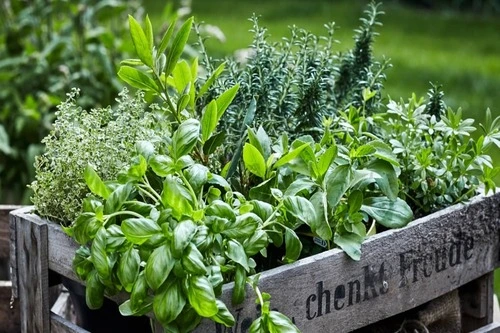Explore 6 Trending Herb Gardening Ideas in 2023
- Author: Saiqa Najeeb
- Last Updated On: July 11, 2023

Do you want to take your herb gardening game to the next level? It’s time to plan a themed herbal garden. The themed herb garden will not only present a visual and sensory pleasure but also tells a tale about your unique interests, passion, and taste.
The type of herbs you want to grow depends upon what you want to get out of your garden. Based on your interest, you can choose from 6 creative herb garden ideas mentioned below.
Let’s explore some fantastic herb gardening ideas!
A Salad Garden

A salad garden is one of the awesome herb gardening ideas for salad lovers. For a salad garden, you can pick from cucumbers in all their varieties, squash, zucchini, onions, garlic, various lettuces (oak leaf, red salad bowl, leaf, head), endive, chicory, chickweed, arugula, orach, chives (leaves and flowers), nasturtium (tasty, peppery flowers), roses (please, none fed or sprayed with systemic), violets, true geraniums, calendulas, borage (great flowers), upland cress, pansies, lavender, rosemary, pinks, mint, parsley, salad burnet (cucumber-like taste), thyme and lemon thyme, fennel (bronze, green, Florence), dill, marjoram, winter tarragon, and the many sorts of basil.
Special Trick: If you have picky eaters who don’t like vegetables, try getting them to eat what you’ve grown in your family garden. The emotional attachment to the plants appears to make all the difference!
A Literary Garden

For literature geeks, the literary garden can be one of the great herb gardening ideas. The Bible, Chaucer, Shakespeare, and many more works (including current mysteries) are all about herbs. Planting a garden with plants described in your favorite books, and putting phrases or references on your herb labels, is a lot of fun. A Biblical garden might feature rosemary, figs, grapes, olives (in a tub), pomegranates, rue, wormwood, Christmas and Easter roses, dogwood, and redbud. and at least 130 other plants!
Unfortunately, many plants referenced in religious literature have lost their exact identification due to centuries of history and changes in the way we now call plants (using Latin “binomial nomenclature”). Shakespeare mentions herbs more than you can throw a stick at, and his references might provide inspiration for a fantastic garden.
A Fragrance Garden

Now that the entire world appears to have jumped on the “aromatherapy” bandwagon, long-time herb-growers are just delighted to see that people are finally accepting what they’ve known all along: herbs and their smells can have a profound influence on how we feel. Herbs can be soothing (lavender), revitalizing (rosemary), or refreshing (mint). Anyone who has seen a cat get “high” on a catnip-filled sock understands how potent plants can be. Potpourri can be utilized throughout the house to create whichever aroma combination you like. Colorful dried flowers can also provide aesthetic appeal to your potpourri, although they are not required.
A few ideas: basil, bayberry, bergamot, chamomile, costmary, heliotrope, hyssop, jasmine, lavender, lemon balm, lemon verbena, lily of the valley, marjoram, mint, oregano, orris root iris, ornamental catnip, pennyroyal, peony, roses, rosemary, sage, salad burnet, savory, scented geraniums, soapwort, southernwood, sweet flag, sweet woodruff, tansy, tarragon, thyme, valerian, violet, yarrow.
A Medicinal Garden

There is a universe of medical lore around the use of herbs, much of which dates back to the beginnings of modern medicine. Herbal medicines are becoming increasingly popular as the emphasis on holistic care grows. Herbal beauty products, such as toners and cleansers, are also gaining favor in the cosmetics industry nowadays. Herbal medicines can take the form of infusions (in which the leaves or blossoms are soaked), teas, or the eating of the actual leaves. Horehound drops can help soothe a cough, valerian (a predecessor of Valium) can help you rest before bed, and chamomile has long been known for its therapeutic abilities.
IMPORTANT NOTE: We will refrain from making specific recommendations for herbal medicinal purposes. Very few have been found to be toxic, but some, such as comfrey, may cause liver damage if ingested in excess.
A Tea Garden

Okay, these herbs have been verified to be completely safe for use in tea preparation. Our only caution is to take it easy: remember that, with the exception of gardening, we should do everything in moderation! Try bergamot, borage, catnip, chamomile, dill, fennel, hibiscus, horehound, lemon balm, lemon verbena, lovage, marjoram, mint, parsley, rose, rosemary, sage, sarsaparilla, sassafras (which grows wild here), strawberry, blackberry, sweet woodruff, thyme, violet, wintergreen.
A Culinary Garden

If you can grow it, chances are you can utilize it in the kitchen. The list below is not exhaustive (remember, the thyme family comprises over 400 varieties, and there are tonnes and tonnes of sages and basils as well), but it should give you some ideas. Garlic, chervil, marjoram, coriander, oregano, dill, chives, borage, basil, horseradish, horehound, mints, leek, bay trees, caraway, anise, salad burnet, cumin, lovage. and, of course, parsley, sage, rosemary, and thyme are all good choices. Take your socks off! Few things in life are more enjoyable than stepping outside your back door to gather fresh herbs for tonight’s grilled fish or chicken.
The End…
Now you have some cool herb gardening ideas to choose from. By using the guide, you can pick and choose the herbs based on the purpose of your herb garden. With this guide, you can select the herb gardening themes and create your own harmonious and thriving herb garden.
So, take your herb gardening to new heights with these herb gardening ideas. Let your herb garden tell a tale that speaks your heart.


